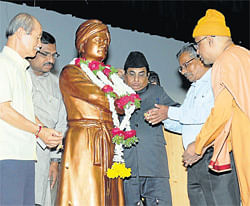
The devastation, destruction, suffering, pain and the impact the first atomic bombs which was dropped on Hiroshima and Nagasaki on August 6 and 9, 1945 (called the Little Boy and Fat Man) respectively by the Americans was captured in all its gory details by one of the Japanese survivor of the disaster, Iso Hiroo at the Senate Bhavan here on Thursday.
Sharing his experience from the age of 4 when he was first exposed to the bomb, 2.5 kilometers from the hypocentre, Hiroo now 71, brought out the poignant moments in his and other people’s lives at the Hiroshima-Nagasaki Day and the inauguration of 150th birth anniversary of Swami Vivekananda organised by the University of Mysore in association with International Association for Religious Freedom, South Asia Coordinating Council-IARF-India Chapter and said that it is 67 years now and the scars are still very deep as he was suffering from radiation damage to his body.
“My body produces only half the normal amount of thyroid hormone. Even now I must have liver tests every six months,” he said.
Speaking in his mother tongue Japanese (which was translated into Kannada by advocate M A Hemalata), Hiroo recalled, “When the atomic bomb was dropped at 8.15 that morning, my father was working in the factory. My sister was a student but she was not at school. She had to work in the munitions factory near Hiroshima station. After a flash and a blast I could not recall anything for a moment. When my mother came to us, the roof of our house was gone and window panes were broken.”
Sufferings
His mother got cancer caused by atomic bomb and was hospitalised for ten years before she passed away. “As we lived in a rural area, our family cremated her body at a crematorium but her cancer part remained as a black lump although we tried to burn it,” he said.
Appealing for the elimination of all nuclear weapons, Hiroo said, “We, A-bomb survivor held ‘Yes, abolition of nuclear weapons,’ campaign throughout Japan from August 2009 to April 2010 and were able to win the approval from two thirds of 1750 local governments. US President Barack Obama is aiming at a world without nuclear weapons. We would like to keep trying hard to eliminate all nuclear weapons by 2020.”
Earlier, Sri Ramakrishna Ashrama, Mysore, president Swami Muktidananda highlighted the significance of Swami Vivkenananda’s thoughts and teachings when he had in his famous address at the Parliament of Religions in Chicago in 1893 said for whom the bell tolls today, this should be the death knell for all violence and conflict.
“Unfortunately what we have seen is not only the devastating Hiroshima-Nagasaki atomic bombings but also the 9/11, because it is the conflict with each other,” he said.
University of Mysore vice chancellor V G Talwar, IARF chairman Thomas Mathew, national president M A Hemalatha, secretary Mohammed Shabeer Ahmed, University of Mysore registrar P S Naik, UGC-Academic Staff College director G Venkatesh Kumar and Mahajana Education Society president Vasudev Murthy were present.